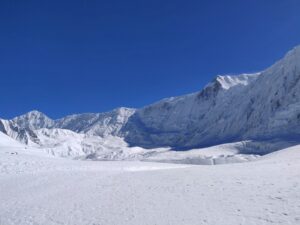I’ll never forget the first time I saw it ice rising like a broken promise against the sky. Island Peak, or Imja Tse as the Sherpas call it, doesn’t look like much from afar. But up close? It’s a beast. At 6,189 meters, it’s where dreams meet crampons, and where the air feels like it’s playing hide-and-seek with your lungs.
I didn’t come here to conquer anything. I came because a friend once said, “If you can climb this, you’ll remember how small you are and how much that doesn’t matter.”
The Warm-Up: Tea, Trails, and Thin Air
The journey starts in Lukla, where planes land on a runway shorter than a football field. From there, it’s a slow dance through Sherpa villages places where yaks outnumber cars, and prayer flags flutter like confetti.
-
Namche Bazaar: A bustling town where climbers swap stories over steaming bowls of thukpa.
-
Dingboche: Stone-walled fields, potato farms, and nights so cold your breath freezes mid-air.
-
Chhukung: The last village before the climb, where guides check your gear and crack jokes to ease the nerves.
Each step higher feels like the world is peeling away layers first the trees, then the warmth, finally the noise.
Base Camp Blues and Ice Axe Lessons
At 5,240 meters, the base camp is a rocky patch of tents surrounded by glaciers. Here’s where reality hits:
-
The Training Day: Guides teach you to swing ice axes like a pro and walk in crampons without tripping. My guide, Pasang, laughed as I fumbled. “Like walking on Lego,” he said, “but colder.”
-
The Night Before: Sleep? Impossible. The wind howls, and your mind races. Did I pack enough socks? Can I really do this?
-
The 2 AM Start: Headlamps pierce the dark. All you hear is crunching boots and your own heartbeat.
The Climb: Where Fear Meets Wonder
The summit push is a blur of ice walls, rope lines, and moments where you ask yourself, “Why did I think this was a good idea?”
-
The Glacier: A frozen river of cracks and blue ice. One slip, and you’re in a crevasse. Trust your rope. Trust your team.
-
The Ice Wall: Near-vertical and slippery. This is where you learn to love your jumar a metal gadget that hoists you upward.
-
The Final Ridge: A narrow path with drops on both sides. Step left, and you’re in Tibet. Step right, and… well, don’t.
And then the summit. The sun rises, painting Everest, Lhotse, and Ama Dablam in gold. You forget the cold. Forget the fear. All that’s left is this: a world so big, it makes your chest ache.
The Descent: Lessons from the Mountain
Going down is harder than going up. Your knees wobble, and the adrenaline fades. But here’s what stays:
-
Sherpa Strength: These men and women carry 30-kg loads in sneakers, smile through frostbite, and know every rock by name.
-
Your Own Limits: Turns out, you’re tougher than you thought.
-
The Silence: Mountains don’t care about your deadlines or Instagram posts. They just are. And somehow, that’s enough.
Why Bother?
Climbing Island Peak isn’t about bragging rights. It’s about learning to breathe when there’s no air left. About sharing chocolate bars with strangers who become family. About realizing that the best views come after the hardest climbs.
So, if you ever find yourself in Nepal, tired of the noise and hungry for something real, look up. Imja Tse is waiting.
Key Points Covered:
-
Cultural immersion: Tea with Sherpas, ancient monasteries, and yak butter candles.
-
Physical demands: Altitude headaches, icy slopes, and the art of “rest-stepping.”
-
Emotional rewards: Sunrise on the summit, the camaraderie of climbers, and the quiet pride of looking back at how far you’ve come.
-
Practical tips: Training routines, gear essentials (crampons, ice axes, warm layers), and why chocolate is a climber’s best friend.